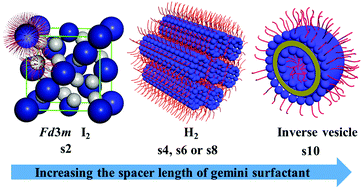Self-assembly of cationic gemini surfactants, alkanediyl-bis-(dimethyldodecyl-ammonium bromide), in cyclohexane: effects of spacer length on their association into reverse lyotropic liquid crystalline or reverse vesicles†
Abstract
Herein, homogeneous solutions of cationic gemini surfactants, alkanediyl-α,ω-bis(dimethyldodecylammonium bromide), referred to as 12-s-12 where s = 2, 4, 6, 8, and 10, in cyclohexane have been prepared with the help of sodium hexanoate (SH) or sodium laurate (SL). These surfactants self-assembled in cyclohexane to form various aggregating structures, which were characterised by small-angle X-ray scattering (SAXS) together with polarised microscopy observations. The results showed that 12-2-12/SH, where the gemini had the shortest spacer among this series, formed an inverse micellar cubic liquid crystalline phase of the Fd3m structure. 12-s-12/SL, including s = 4, 6, and 8, which contained an adequate length spacer, formed an inverse hexagonal liquid crystalline phase packed by the cylindrical assemblies of surfactants. 12-10-12/SL, in which the gemini had a longer spacer, formed dispersed reverse vesicles (a lamellar structure). The rheological properties of liquid crystalline phases in a linear visco-elastic regime were studied. 12-2-12/SH formed a hard gel, whereas 12-s-12/SL formed soft gels. Dynamic light scattering and steady-state viscosity analyses were performed for the reverse vesicle solutions formed by 12-10-12/SL. In all these systems, the amount of added water W0, denoting the mole ratio of water to the gemini surfactant, was demonstrated to influence the properties.



 Please wait while we load your content...
Please wait while we load your content...